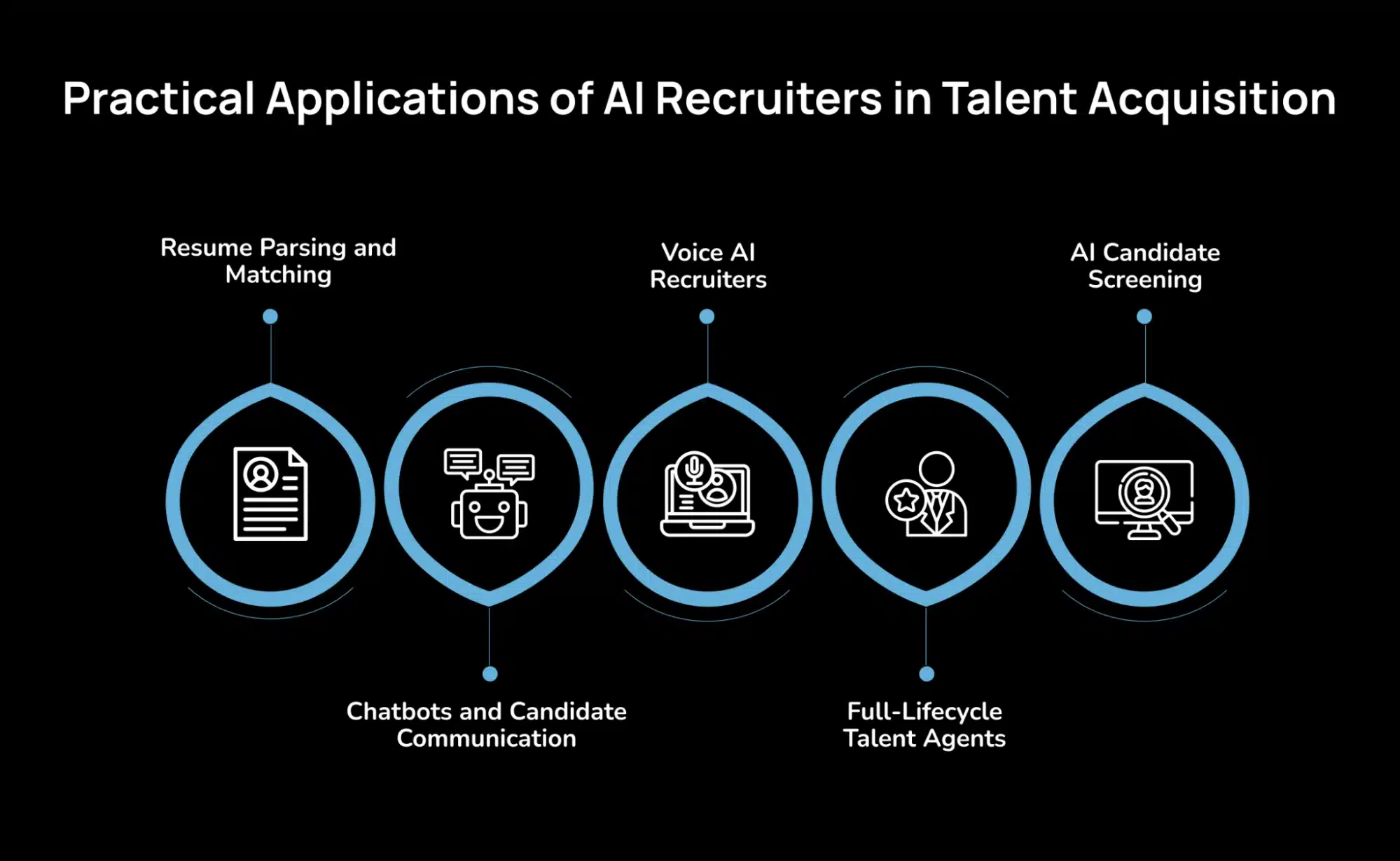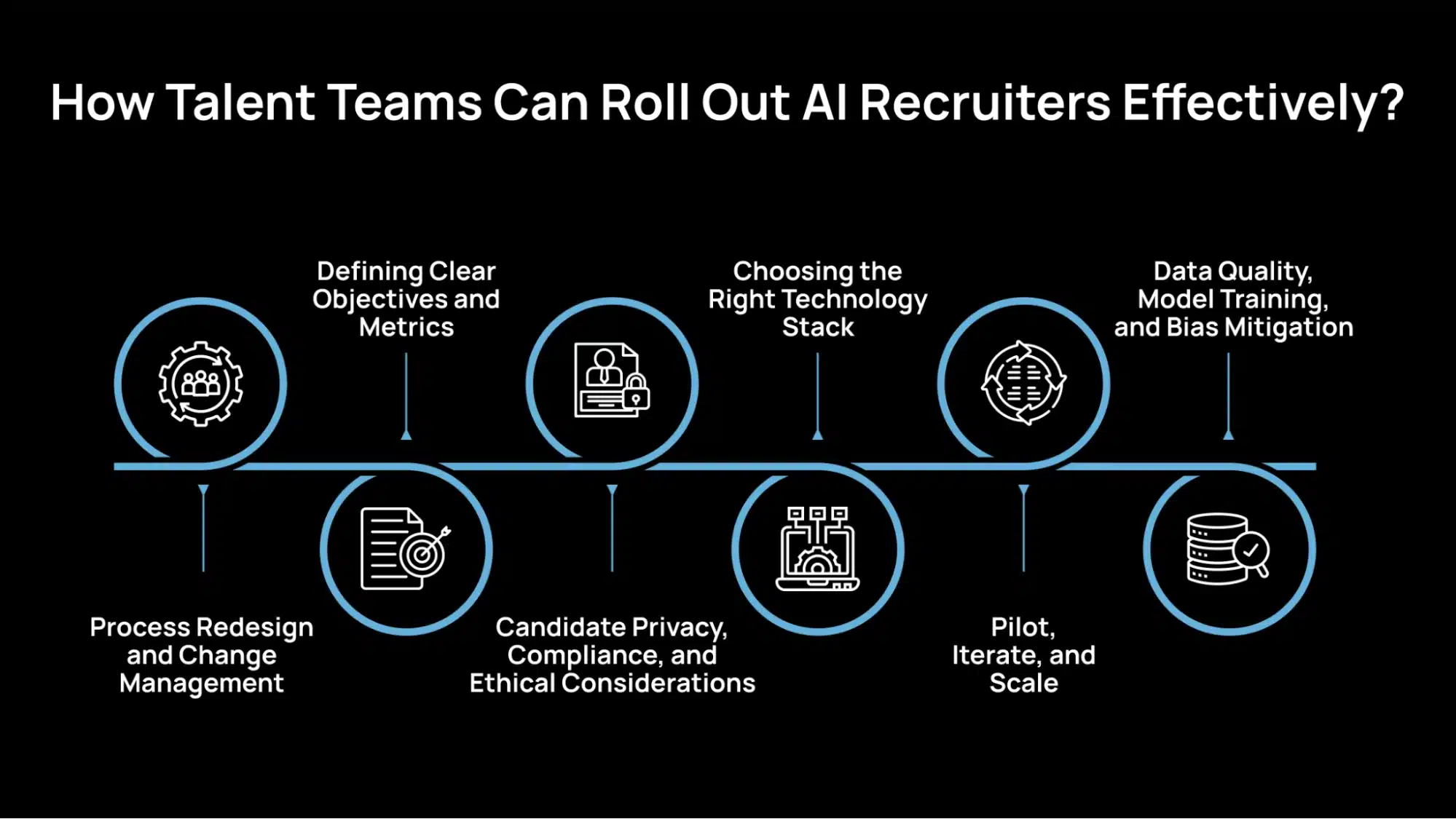Hiring is changing fast, and if your team still uses the same process as five years ago, you’re already behind.
A recent study found that 71% of job seekers are likely to abandon the process if the recruitment experience is too slow or complicated. That’s a big deal for teams trying to hire in a competitive market.
This is where an AI recruiter helps. An AI recruiter is not a magic robot that replaces humans. It’s a system powered by artificial intelligence that automates and supports key hiring tasks, including sourcing talent, screening applications, conducting preliminary conversations (including via voice), and helping human recruiters focus on the decisions that matter.
In 2025, the technology has matured to the point where deploying voice-based candidate interaction and advanced screening is practical. Regulatory and ethical frameworks are evolving, making transparency, fairness, and data protection non-negotiable.
Candidates now expect fast, mobile-friendly, personalized hiring experiences, not waiting days or getting lost in a black hole.
In this blog, you will learn what an AI recruiter really means today, how tools like voice AI recruiters and AI candidate screening work, and how to deploy and utilize them to improve speed, accuracy, and candidate experience.
TL;DR
|
Why Conventional Talent Acquisition Can’t Keep Up in 2025?
Talent acquisition teams in 2025 face two persistent challenges: an overwhelming number of applicants and a shortage of qualified ones.
The real struggle isn’t attracting applicants; it’s retaining their attention. High-performing professionals often receive multiple job offers simultaneously, and the hiring speed can significantly influence who ultimately wins the position.
1. Skill Shortages in Niche Roles
Despite the flood of applications, there’s a shortage of candidates with specialized skills, particularly in areas such as AI engineering, cybersecurity, and data analytics. These roles demand hands-on expertise, and candidates often prefer project-based or remote work arrangements. This leaves recruiters competing for the same limited talent pool across geographies, driving up hiring costs and extending time-to-fill metrics.
What this means for talent teams:
- Standard sourcing methods are no longer enough; teams need predictive tools that highlight fit over volume.
- Speed and personalization are now baseline expectations, not differentiators.
- Building relationships and maintaining active talent communities helps balance short-term hiring with long-term workforce planning.
2. Rise of Digital-First Candidate Expectations
Candidates now expect recruitment to match the digital experience they get as consumers, fast, transparent, and mobile-friendly. Long application forms or delayed follow-ups often lead to drop-offs before the first interview.Generic messages or outdated ATS emails can harm an employer’s credibility. Simple changes, such as dynamic messaging or automated status updates, can make a significant difference.
3. Mobile and On-Demand Interaction
More than half of job seekers now browse and apply using mobile devices. Voice assistants, chatbots, and AI recruiters are becoming natural extensions of this trend. A voice AI recruiter, for example, can schedule interviews or answer FAQs instantly, reducing friction and keeping candidates engaged.
For talent teams:
- Review every touchpoint for accessibility and clarity on mobile.
- Prioritize real-time responses, automation can help, but empathy must guide the process.
- Use data to segment and tailor communication, but avoid over-automation that feels impersonal.
Why Talent Teams Are Turning to AI Recruiting?
Recruiters are managing more applications, working under tighter timelines, and facing higher expectations than ever. Here is why relying on AI recruiter systems is now essential to stay efficient and competitive in fast-moving talent markets.
1. Automation Replacing Repetitive Tasks
The conventional recruiting model relies heavily on repetitive administrative tasks, such as sorting resumes, scheduling interviews, and managing follow-ups. These tasks take time but add little strategic value. AI recruiting tools automate these steps, allowing human recruiters to focus on what matters most: assessing culture fit, building relationships, and making informed hiring decisions.
Automation doesn’t replace recruiters; it augments their capabilities. For example,
- Resume parsing tools instantly identify relevant skills, reducing initial screening time by up to 70%.
- AI chatbots or voice AI recruiters handle first-round communication, answering candidate questions and scheduling interviews 24/7.
- Predictive analytics highlight which applicants are most likely to succeed, guiding recruiters toward better choices.
This shift frees talent teams from repetitive work and enables them to make more strategic, insight-driven decisions. As a result, hiring cycles shorten, candidate experience improves, and recruiters can focus on relationship-building instead of routine filtering.
2. Data-Driven Hiring Decisions
Data has become the foundation of modern recruiting. Instead of relying on instinct or surface-level qualifications, AI systems analyze patterns from thousands of data points, including skills, past performance, and cultural indicators, to recommend the best-fit candidates. Talent intelligence platforms consolidate data from multiple sources, including job boards, LinkedIn profiles, and internal ATS systems. This helps teams:
- Identify top candidates faster: Algorithms detect potential matches even when resumes use different languages or formats.
- Reduce bias: Structured, data-led assessments minimize subjective judgments in screening and interviews.
- Forecast hiring outcomes: Predictive analytics reveal which hires are more likely to stay longer or perform better, helping to reduce turnover.
For talent leaders, this means decisions are no longer based on guesswork or outdated processes. Every hire becomes part of a measurable system that improves over time. AI recruiting tools bring structure, transparency, and consistency, qualities that modern talent acquisition can’t function without.
Practical Applications of AI Recruiters in Talent Acquisition
The scope of AI recruiting has expanded well beyond task automation. Today, recruiters utilize integrated platforms that combine multiple capabilities, allowing them to manage end-to-end hiring within a single ecosystem.
1. Resume Parsing and Matching
Modern AI tools instantly extract key details from resumes, skills, experience, education, and achievements, and match them to job descriptions.
This eliminates the need for manual sorting, allowing recruiters to focus solely on qualified candidates. Advanced systems can even understand context, such as recognizing synonyms (“sales executive” and “account manager”) to avoid missing good fits.
2. Chatbots and Candidate Communication
AI-powered chatbots engage with applicants in real time. They answer FAQs, share company updates, and even guide candidates through application steps.
This creates an always-on recruiting experience that keeps candidates informed and reduces drop-offs due to delayed responses.
3. Voice AI Recruiters
Voice-based AI recruiters represent the next evolution in interaction. These systems conduct preliminary interviews or screening calls using natural, conversational language.
They can verify availability, clarify experience, and assess communication skills without human intervention. This adds speed and convenience for both candidates and recruiters, while maintaining a personal and conversational tone.
4. Full-Lifecycle Talent Agents
The most advanced AI platforms act as virtual recruiting partners. They source candidates from multiple channels, schedule interviews, handle follow-ups, analyze results, and even provide post-hire insights, such as onboarding progress or risk of retention.
These agents integrate seamlessly with existing ATS and HR systems, ensuring a seamless flow of data and visibility across the entire hiring journey.
5. AI Candidate Screening
At the heart of every AI recruiter lies AI candidate screening, the process of evaluating applicant data to identify the strongest fits quickly and objectively.
- Filtering: The system automatically removes unqualified applicants by checking for essential criteria (skills, experience, certifications). This reduces recruiter workload and ensures consistency across roles.
- Matching: Algorithms compare each candidate’s profile with job requirements, scoring how closely they align with desired attributes. The more sophisticated the model, the better it understands contextual relevance, for example, transferable skills or industry-specific terminology.
- Ranking: Candidates are prioritized based on predictive success metrics, including the quality of their experience, skill match, and cultural alignment. Recruiters can instantly view top-ranked profiles, making decisions faster and more data-driven.
This combination of filtering, matching, and ranking transforms what was once a manual, error-prone process into a structured, measurable workflow. It ensures hiring teams focus their time where it matters, evaluating top talent instead of sorting through applications.
Core Functions of AI Recruiters in Modern Talent Teams
Here’s how AI recruiters support modern talent teams across key hiring functions, making every stage faster, more innovative, and more consistent.
1. Sourcing and Candidate Attraction
AI recruiters analyze large datasets across platforms, including LinkedIn, job boards, and social networks, to identify patterns and potential matches. They can predict which candidates may be open to new opportunities based on activity, tenure, or skill trends. This enables teams to build stronger, future-ready talent pipelines, rather than reacting to every new vacancy.
- AI tools craft tailored messages using candidate data (skills, experience, interests), thereby improving response rates and the quality of engagement.
- Voice-based AI recruiters can initiate early-stage interactions, such as asking about availability, confirming interest, or explaining job details, thereby reducing the time recruiters spend on repetitive calls.
AI-driven sourcing shortens the search cycle, keeps pipelines active, and ensures every interaction feels relevant to the candidate.
2. Interviewing and Assessment
Coordinating interviews and assessments across multiple candidates can slow down the hiring process. Manual evaluations often vary by interviewer, leading to inconsistent results.
- AI recruiters standardize the early interview process using automated screening, structured assessments, and analytics-based evaluation.
- Voice AI recruiters can conduct initial interviews, asking pre-set questions and analyzing tone, clarity, or keyword alignment.
- Tools evaluate real-time responses, communication, and skill application in a simulated environment. Interactive tasks assess cognitive and problem-solving abilities in a non-traditional format, providing deeper insights into a candidate’s fit.
Recruiters gain consistent, data-backed insights while freeing time for high-value interviews with top-tier candidates.
3. Candidate Experience and Engagement
Candidates expect timely communication and clarity at every step. Long waits or generic emails lead to disengagement and negative perceptions of the employer brand.
- AI-driven personalization ensures that candidates receive relevant, timely, and consistent updates.
- Chatbots and voice assistants keep communication active and accessible around the clock, guaranteeing continuous interaction and accessibility.
- AI tailors messages and recommendations based on each candidate’s stage and role. Automated systems send reminders, confirmations, and follow-ups, reducing uncertainty.
- Voice AI recruiters can answer FAQs, schedule interviews, or confirm next steps within minutes.
While AI improves efficiency, candidates still value genuine human interaction. Recruiters must maintain a personal touch in final interviews and feedback to preserve authenticity.
4. Decision-Making and Insights
Recruitment decisions often rely on intuition rather than data. Without clear metrics, it’s hard to track hiring quality or improve future outcomes.
- AI brings structure and objectivity to hiring decisions. It aggregates data across sourcing, screening, and interviews to generate actionable insights.
- AI identifies which candidates are likely to succeed based on historical performance data.
- Recruiters can instantly monitor time-to-hire, offer acceptance rates, and diversity metrics.
- The system continuously learns from past hiring patterns, refining recommendations over time.
Recruiters make faster, evidence-based decisions, improving both hiring quality and team productivity.
5. Onboarding and Internal Mobility
Once hired, many employees face a disconnected onboarding experience. HR teams manually manage training, documentation, and progress tracking. This slows down integration and increases the risk of early attrition.
- Automated workflows deliver training schedules, documentation, and reminders to new hires.
- AI systems recommend personalized learning modules tailored to an individual’s role, skills, and career goals.
- AI identifies employees ready for promotion or lateral movement by analyzing performance data, engagement scores, and skill development.
The same intelligence that drives external hiring now supports retention and growth, helping organizations strengthen their internal talent ecosystem.
How Talent Teams Can Roll Out AI Recruiters Effectively?
Here’s what strategic talent teams should look for when rolling out AI recruiter tools effectively.
1. Defining Clear Objectives and Metrics
Before adopting AI recruiting tools, teams need clarity on what they want to achieve. Objectives should be specific, such as reducing time-to-hire, improving candidate quality, or increasing diversity in hiring. Without a clear purpose, even the best tools can create confusion rather than progress.
Key performance indicators (KPIs) help measure impact and guide adjustments. Common metrics include:
| Key Performance Indicator | Description |
| Time-to-hire | How much faster are you filling roles compared to manual processes? |
| Quality of hire | Are new hires meeting performance expectations? |
| Candidate experience | Are candidates more engaged and responsive? |
| Diversity ratio | Has AI helped reduce bias in the sourcing and screening process? |
Clear metrics ensure every technology decision supports measurable business goals.
2. Choosing the Right Technology Stack
Selecting the right tools is critical. Look for systems that combine essential AI recruiter capabilities, including voice AI recruiter features, AI candidate screening, and seamless integration with your ATS or HRIS. Focus on platforms that:
- Scale easily as hiring volumes grow.
- Offer transparent data handling and reliable vendor support.
- Provide user-friendly interfaces to simplify recruiter adoption.
Avoid overcomplicated systems that require extensive training or ongoing technical support. The right stack should fit smoothly into existing workflows and enhance recruiter efficiency from day one.
3. Data Quality, Model Training, and Bias Mitigation
AI is only as good as the data it’s trained on. Inadequate or incomplete data can lead to biased or inaccurate results. Ensuring clean, representative, and diverse datasets helps create fair and reliable algorithms. Regular model training ensures systems remain aligned with evolving job requirements and candidate profiles. Teams should:
- Continuously monitor outcomes for unintended bias.
- Audit algorithmic decisions and maintain transparency in scoring logic.
- Include diverse data samples to ensure equitable evaluation of candidates.
This process is not a one-time event; it requires ongoing attention to maintain the system’s objectivity and compliance.
4. Process Redesign and Change Management
Integrating AI into recruiting isn’t just a tech upgrade; it’s an operational shift. Teams must redefine workflows to decide where automation is beneficial and where human judgment remains essential.
- Let AI handle repetitive tasks, such as resume screening, scheduling, and reminders. Recruiters should focus on conducting thorough interviews, negotiating effectively, and fostering strong relationships.
- Equip recruiters and hiring managers to interpret AI insights and adjust decisions accordingly.
- Keep stakeholders informed about what’s changing and why, to encourage adoption and trust.
Smooth change management ensures AI enhances performance rather than disrupting established routines.
5. Candidate Privacy, Compliance, and Ethical Considerations
As AI systems handle sensitive candidate data, compliance and transparency are non-negotiable. Regulations in 2025 increasingly emphasize algorithmic transparency, data protection, and explainability. Organizations must:
- Clearly disclose the use of AI during the recruitment process.
- Store and process data in line with privacy laws (e.g., GDPR or local equivalents).
- Ensure voice-based interactions are consensual, recorded securely, and compliant with communication standards.
Ethical recruiting involves striking a balance between automation and fairness. Candidates should always have the right to understand how their data was used in decisions.
6. Pilot, Iterate, and Scale
AI implementation works best when tested in stages. Begin with a pilot project, focusing on a single department, role type, or hiring function. Track results, gather feedback, and refine the system before expanding further. Some of the crucial steps include:
- Measure early results against predefined KPIs.
- Adjust algorithms or thresholds where needed.
- Use recruiter and candidate feedback to fine-tune workflows.
- Scale gradually across more teams once a consistent value is proven.
Iterative scaling reduces risk, ensures user confidence, and helps align technology outcomes with long-term hiring goals.
How Avahi AI Voice Agents Support Modern AI Recruiters?
In 2025, speed and availability are critical in recruitment. Missed candidate calls, delayed responses, or scheduling bottlenecks can result in lost great hires.
This is where Avahi’s AI Voice Agent becomes a valuable tool for talent acquisition teams. It acts as an extension of your recruiting process, qualifying candidate inquiries, scheduling interviews, and routing calls to recruiters when needed, all while ensuring a seamless, human-like experience.
For recruitment teams handling high volumes or operating across multiple time zones, Avahi’s voice AI helps maintain consistent engagement, even outside of business hours. It reduces administrative load by managing repetitive candidate interactions, including confirming availability, handling FAQs, logging candidate data into your CRM or ATS, and sending reminders. The result: recruiters spend more time on meaningful conversations and less on coordination, while candidates get fast, professional responses anytime they call.
Discover Avahi’s AI Platform in Action
At Avahi, we empower businesses to deploy advanced Generative AI that streamlines operations, enhances decision-making, and accelerates innovation—all with zero complexity.
As your trusted AWS Cloud Consulting Partner, we empower organizations to harness the full potential of AI while ensuring security, scalability, and compliance with industry-leading cloud solutions.
Our AI Solutions Include
- AI Adoption & Integration – Leverage Amazon Bedrock and GenAI to Enhance Automation and Decision-Making.
- Custom AI Development – Build intelligent applications tailored to your business needs.
- AI Model Optimization – Seamlessly switch between AI models with automated cost, accuracy, and performance comparisons.
- AI Automation – Automate repetitive tasks and free up time for strategic growth.
- Advanced Security & AI Governance – Ensure compliance, detect fraud, and deploy secure models.
Want to unlock the power of AI with enterprise-grade security and efficiency? Start Your AI Transformation with Avahi Today!
Frequently Asked Questions
1. What is an AI recruiter, and how does it work?
An AI recruiter is a digital system that automates and enhances various parts of the hiring process, including sourcing, screening, scheduling, and candidate communication. It uses algorithms, natural language processing, and machine learning to analyze applicant data, match candidates to roles, and streamline recruiter workflows. Instead of replacing human recruiters, it helps reduce manual workload and improve decision speed.
2. How is a voice AI recruiter different from a chatbot or email-based system?
A voice AI recruiter interacts with candidates through voice calls rather than text. It can answer FAQs, qualify applicants, schedule interviews, and even route calls to human recruiters when needed. Unlike static forms or email threads, voice AI enables real-time, conversational engagement, ideal for candidates who prefer quick answers or phone-based communication.
3. Can AI candidate screening actually improve the quality of hires?
Yes, AI candidate screening helps recruiters focus on the most qualified applicants by using predictive models to assess skills, experience, and fit. It filters out unqualified resumes, reduces bias in early stages, and prioritizes candidates based on role-specific benchmarks. This leads to faster decisions and often better alignment between the candidate and the role.
4. Is it safe to use AI recruiters with sensitive candidate data?
Modern AI recruiter platforms are typically built with strict data security protocols. Many, like those powered by AWS or similar providers, offer encryption, access controls, and audit logs to meet compliance standards. Still, it’s essential to select vendors that are transparent about how data is utilized, particularly when implementing features such as voice AI recruiters or automated screening.
5. What types of companies benefit most from AI recruiter tools?
Any company dealing with high-volume hiring, distributed teams, or time-sensitive recruitment cycles can benefit from an AI recruiter. Industries such as healthcare, retail, customer service, and staffing firms are most significantly impacted. Tools like AI candidate screening and voice AI recruiter systems enable these teams to respond faster, reduce manual tasks, and provide a consistent candidate experience across different locations and time zones.







